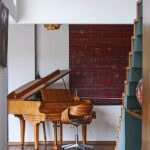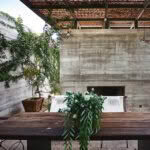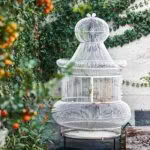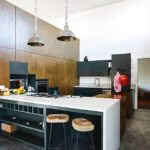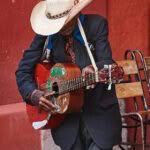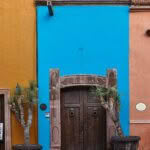Explore this Kiwi film-maker’s home in Mexico — where she’s lived for 36 years
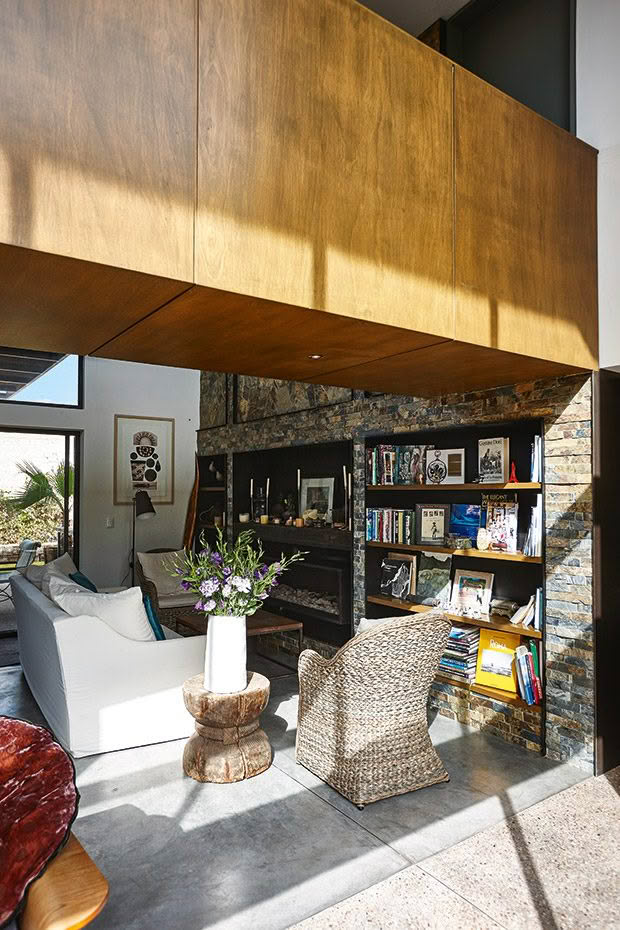
The bridge serving as a walkway to a guest room is an architectural device that intercepts the lofty volume of the main living room and provides storage underneath.
The vibrant spontaneity of a city where a circus troupe might suddenly appear amid the colourful buildings appealed to the creative spirit of this film-maker. So she relocated to México’s San Miguel de Allende — and never left.
Words: Claire McCall Photos: Kevin Emirali
It took Fran Fisher all of about three seconds to dream up the name of the personality that would put her into the pages of a glossy publication — but not into the spotlight.
As the originator of Metro magazine’s Felicity Ferret, the anonymous socialite who exposed the naughtiness of Auckland’s salacious party scene in the early to mid-1980s, Fran was a gossip-column pioneer. “I thought Metro needed some spicing up, so I pitched the idea to [editor] Warwick Roger.”
Spice is right. Fran has always sought the life less ordinary. She rather enjoys nurturing the rebel within. When she took on the undercover mantel of she-who-dished-the-dirt (“but in a flippant, light-hearted way”), she observed much about others but even more about herself. Although The Ferret became a celebrity, Fran did not.
“It’s not something I’m proud of, and I was young and trying to make my mark on the world, but I learnt how important recognition was to me — not fame and fortune but being a valued, acknowledged member of the community. Thank god, being a famous incognito gossip columnist wasn’t the legacy I was born to leave.” After a year, she passed the baton on.
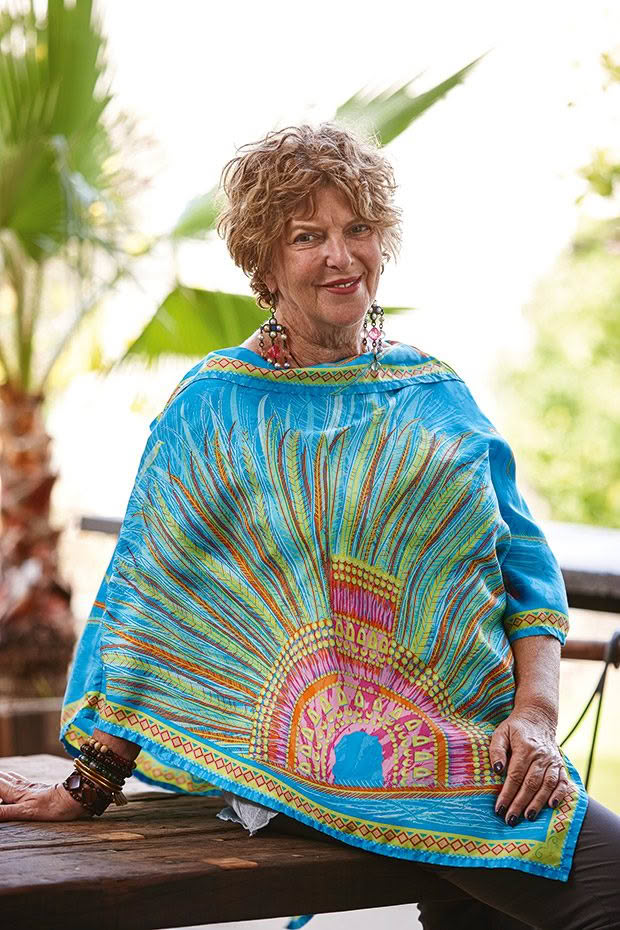
Fran has met many creative characters during her years living in Mexico and wears a silk top by Mexican designer Cristina Pineda. “She derives her prints from Huichol Indian art, and is inspired by the natural world of butterflies, hummingbirds and the exotic flora of Oaxaca.”
By then, of course, she had other fish to fry. Quite literally. Her modus operandi has always been quick-change adventure. By the time Fran was 28, she had already studied journalism, then anthropology (although she dropped out of her Otago University course), owned a restaurant on Ponsonby Road, and worked as a copywriter in an ad agency. She was also involved with the film industry — as a screenwriter and director of commercials.
Ultimately, in an expression of creativity that pulled all her multi-layered interests together, she produced a documentary about tuna fishermen. “I had a close friend in Nelson who introduced me to a team that went away to work on the big purse seiners in Fiji. They’d return home all discombobulated, albeit with a lot of money to spend. I was immediately interested in them as characters.”
To gain the trust of 14 rough-and-ready guys before filming, Fran asked to join them on a “dummy run” — a month-long expedition to the fertile fishing grounds off the Bay of Plenty. She offered to cook. As the only female on the 150-foot vessel, the situation required careful navigation. “But because the cook is up before everyone else and goes to bed last, I gained a lot of respect.” She won their confidence.
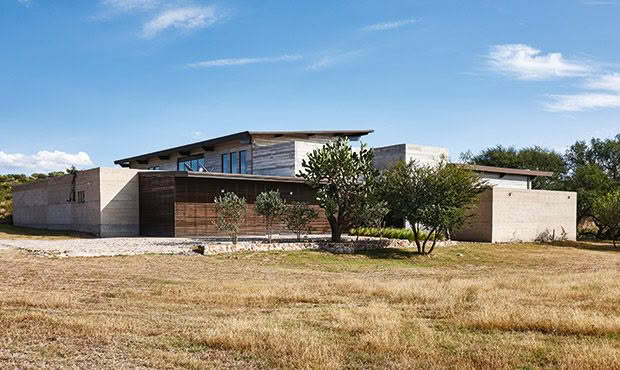
Local clay was used for several of the monolithic walls of the house, which sits in a monochromatic landscape surrounded by a garden incorporating native plants that need little irrigation. “In the sunny, dry winters, the temperature can plunge from the 20s to freezing at night but our afternoon rains in the summer keep the temperature near perfect.”
In life’s complex tapestry, it’s only when one steps back that one realizes how the threads are interconnected exactly as they should be. The film Maritime Mavericks screened on New Zealand television and then on the festival circuit, which is how Fran found herself with a girlfriend visiting the United States to tout its merits to programmers. A hop-skip over the border and they were relaxing on a Mexican beach where Fran, who had a fascination for pre-Hispanic culture and mythology, felt the thrill of instant connection.
“I was so stimulated; I immediately started writing stories in my head.” A contact told them about a town that was a magnet for poets, musicians, artists, authors and the like; Fran felt the inevitable pull.
Día de la Candelaria is a festival that marks the start of spring in México. Flower sellers fill the streets, a special candle-lit mass is held to celebrate and, in the evening, family members gather to feast on tamales and drink atole, a cinnamon and vanilla-flavoured hot drink.
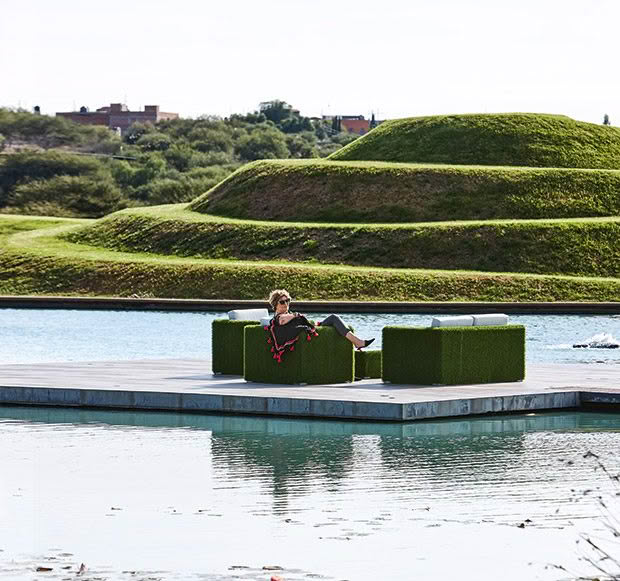
The absurdity of “lawn furniture” made of fake grass appealed to Francesca Fisher’s playful nature. It occupies a stage in the middle of a lake at Valle de Los Senderos, a residential/resort development that Fran has helped to develop and where she has her home. The lake, called Manaia after the Māori guardian of earth, sea and sky, is overlooked by a grassy sculpted amphitheatre where weddings, festivals and concerts are held.
“I will never forget that first day arriving into the town square at San Miguel de Allende — it was so magical. The cathedral at the end of the main street was like the fairy castle of the Disney logo,” says Fran. She was enchanted by the physical beauty of the quaint cobbled roads and colourful buildings inspired by the vibrancy of the people.
“I thought I’d rent an apartment for a couple of weeks and write,” says Fran, who changed her name to the more Spanish-sounding Francesca. So far, she has stayed 36 years.
If Francesca wanted excitement, she got it in spades. Her first role dropped into her lap when the director of a German record label, who came to shoot a music video for a band called Alphaville, unexpectedly got ill and needed to be replaced. “La Kiwi Gringa” got the gig. It was a blessing and a curse. The upside? The budget was pretty impressive.
- “Mexicans tend to take responsibility for their own safety,” says Fran, hence this staircase has no handrail. “And since I don’t have small children staying and I warn my sleepover guests not to drink margaritas before navigating them, so far that hasn’t been a problem.” The urn beneath the stairs is part of a three-piece collection by a Japanese ceramicist and the pitchfork is a decorative piece from an interior design store.
- Fran shipped the baby grand from New Zealand in the late 1980s, about the same time Jane Campion was making her movie The Piano. “Fortunately, mine didn’t sink to the bottom of the ocean.” Fran plays for relaxation — classical and improvised blues.
The flipside? “The producer insisted on snorting the budget up his nose.” When it came down to it, there was no money left to pay the Mexican crew, so Francesca was left to sort it out.
“I certainly learned what chutzpah I had. I managed to convince the German production manager to get in an aeroplane and secure more money — actual cash in a suitcase — while the crew and I were threatening to flush the film down the toilet.”
Just for good measure, there was a car chase, as the Mexican highway cops tracked down the European musicians and entourage who were holed up in a hotel in México City, and confiscated their passports until everyone got paid.
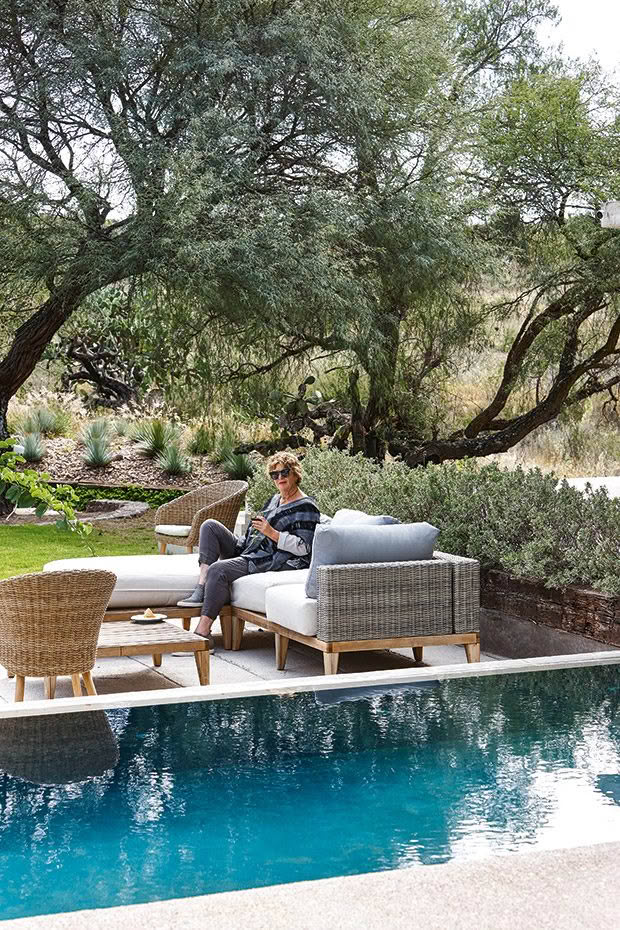
Fran usually likes to have friends over year-round, and the home’s al fresco areas are perfect for that. “I like to invent recipes that blend Kiwi, Asian and Mexican flavours but I love a good ribeye with fries for an occasional secret binge”.
Although this was a madcap beginning, an essential part of Francesca relished the drama. It certainly didn’t put her off. Film continued to be her métier. Francesca wrote a magic-realism short film based on the American artist who shared her work studio and his Mexican model (a “curandera”, or a native healer/shaman with a dark side).
Later she fleshed out the idea as her first feature film — a bilingual piece called Shadow of the Peppertree. She describes the film as a profoundly Jungian story that explores people’s light and dark sides and the one they choose to inhabit.
Francesca has always enjoyed morphing between the world of dreamscape and physical landscape. Once she was fully fluent in Spanish, she set up a production company to facilitate foreigners shooting movies in the city, which is a UNESCO World Heritage site.
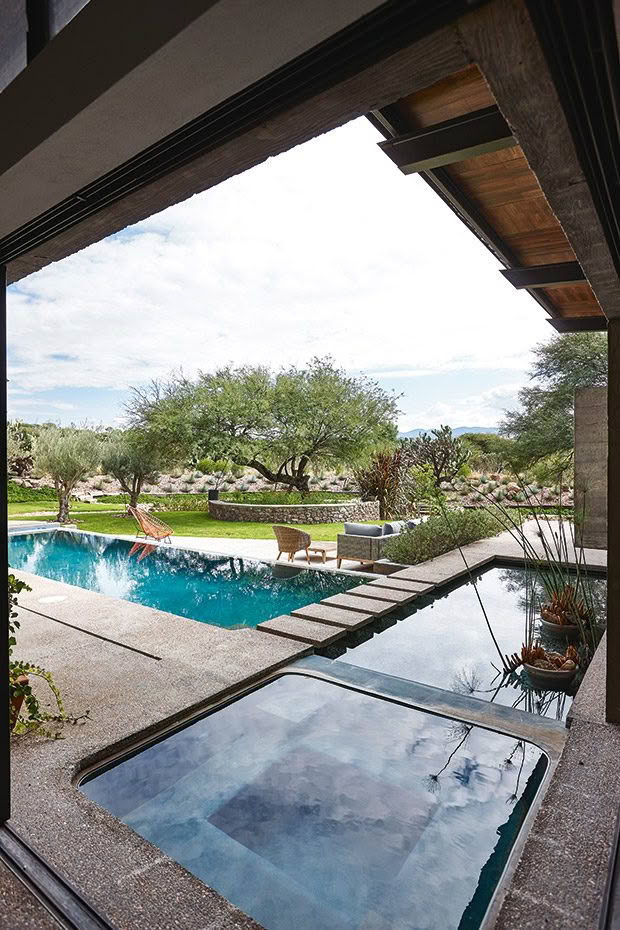
A mesquite tree — the hardwood granddaddy of Mexican trees — grows in the centre of the courtyard, which is cooled by reflection ponds and a pool. Mesquite is famous for its wood chips, which provide smoky flavour on the barbeque, and the flour ground from its sweet, nutty seed pods is high in protein.
She married a well-known gold- and silversmith, Peter Woods (a fellow New Zealander), then divorced and, just before the GFC hit, spearheaded a project to develop 125 hectares of land on the edge of town into a full-service film-studio facility. (She spent many nights pretending to drink glass after glass of cheap tequila with the one-time cowboy star of spaghetti westerns who owned the land to convince him to sell.)
- Several climbers soften the walls of the home, including a ficus, a passion vine, jasmine, clematis and wisteria; while Covid-19 has put a dampener on entertaining.
- The outdoor dining table is from local design store Namuh, one of Fran’s favourite places for interesting pieces.
- This white cage is used to transport Fran’s yellow-naped amazon parrot named Rangi (whose companion, Toto, was unfortunately lost when Fran moved house).
“The master planning of the backlots was designed to maximize the terrain. There was to be a body of water for filming miniatures and underwater scenes plus a natural one flanked by bamboo and full of reeds that would double for jungle scenes or Vietnam.” Francesca honed her latent skills as a landscape designer, and these have now evolved into beautiful waterscapes, which are a focal point of the property.
When the Hollywood investment in the ambitious project dried up after the 2007 financial crises, the deal stalled. But Francesca is happy to say that, 17 years later, her company has now paid off the last instalment to freehold the land.
She has also designed her own home on the property — a contemporary pavilion of concrete and earth cement with wooden floors and reflection ponds around its perimeter to beat the heat. It is a base for her work and her play, although mostly they intersect.
- The barstools in Fran’s kitchen are from Namuh, and the pendant lights were a real find — or so she thought. “I dragged those lights across the south of France on trains, past gipsy thieves and back to México, to discover that a store here carries them”.
- The elaborate chair was found in a consignment store in town, and the lamp is Mexican and made of balsa wood. “It casts a magical light on the wall through the spiral form.”
Over the decades, she has amassed so much experience but also a fantastic circle of friends. While she misses family, Fran continues to make her annual trip “home” to Auckland to visit and, together with a group of old mates, heads to her family’s 1950s bach on Kawau Island for “laughter, cards and silliness”. The extraordinary emerald colour of the sea, the night phosphorescence, the call of weka and the fabulous upside-down-ness of the night skies is what she returns to when she needs a dose of “Kiwi kalm”.
With no plans to return full time, Fran makes sure she always goes back to México armed with a big jar of Vegemite, a tin of golden syrup, and enough Rotorua mud skincare product to get her through the year.
Life in México might be unpredictable at times, but she sees that as a bonus. “One day, I was in town when, around the corner, came a full circus troupe with Indian elephants adorned with head-dresses, and clowns and acrobatic performers. It was like something from a Fellini movie. México has drawn out my creative potential. And even when it’s stressful, it’s joyful.”
MEXICAN TIPPLES TO TRY
Francesca’s close friends own a small hotel on the coast in Oaxaca where she was introduced to mezcal. Visitors to Los Senderos might taste a local gold-medal Bacanora mezcal called Santo Cuviso.
The world-famous Tequila Casa Dragones got its start in San Miguel de Allende and has a fabulous tasting room in the heart of the town. “They’re both boutique brands so I doubt they’d be available in New Zealand.”
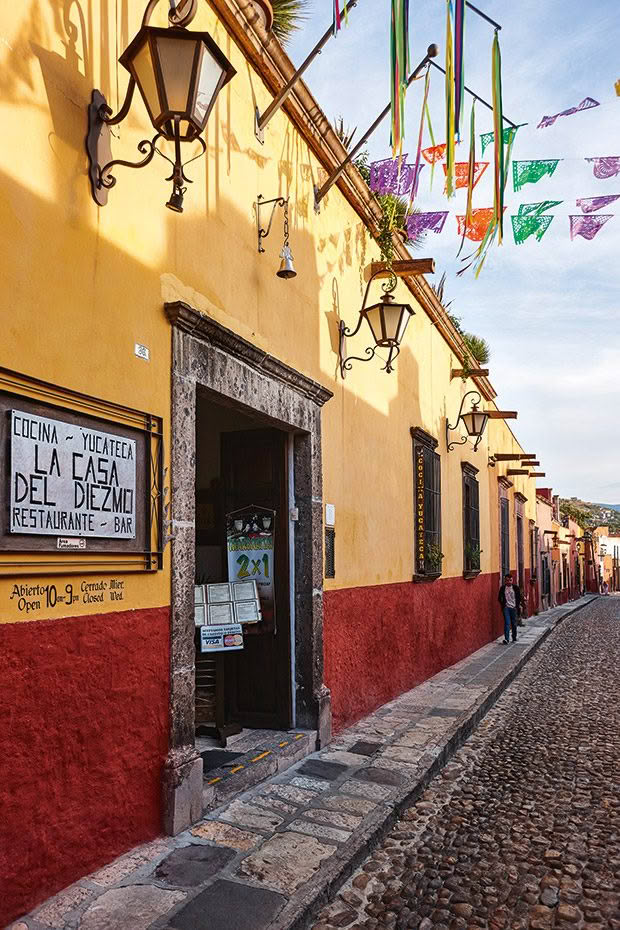
Every street in downtown San Miguel (named the world’s No1 small city to visit on several occasions by Travel & Leisure magazine) is picturesque, and there are more than 40 churches.
For novices, the softer añejo (golden, aged) tequilas are best. Go for the Tradicional or Don Julio brands.
México produces excellent, quaffable red wines. “In my opinion, they have more depth and personality than their Chilean or Californian counterparts — especially those from the Ensenada/Casa Madero area.”
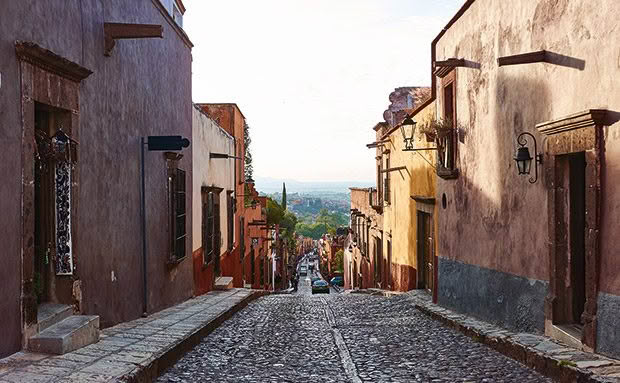
Francesca’s favourite is Monte Xanic. Look for Bordeaux-style blends: merlot, syrah, cabernet sauvignon that have a rounder, balanced flavour. “Our local terroir is starting to produce some very noble wines and the region is becoming trendy for visits to tasting rooms and restaurants at local wineries.”
PANDEMIC PAUSES
Fran has been dealing with the devastating fallout of Covid-19, which has made it challenging to keep the Valle de Los Senderos project afloat without laying off staff. But there is a silver lining.
- It’s common to see musicians of all ages busking on the street, trying to make ends meet. There’s fantastic music to be enjoyed in patio bars and an abundance of concerts and festivals from jazz to Latin, classical and opera.
“Within our market sector, there’s a new awareness and desire to connect with a sustainable and natural lifestyle,” says Fran. “So the future is looking brighter.”
Fran has learnt to appreciate the time and space the partial shutdown has given her to reflect on her own spiritual and creative growth. “While I miss the occasional party and hugs with friends. I am blessed to live where I do.”
Love this story? Subscribe now!
 This article first appeared in NZ Life & Leisure Magazine.
This article first appeared in NZ Life & Leisure Magazine.

